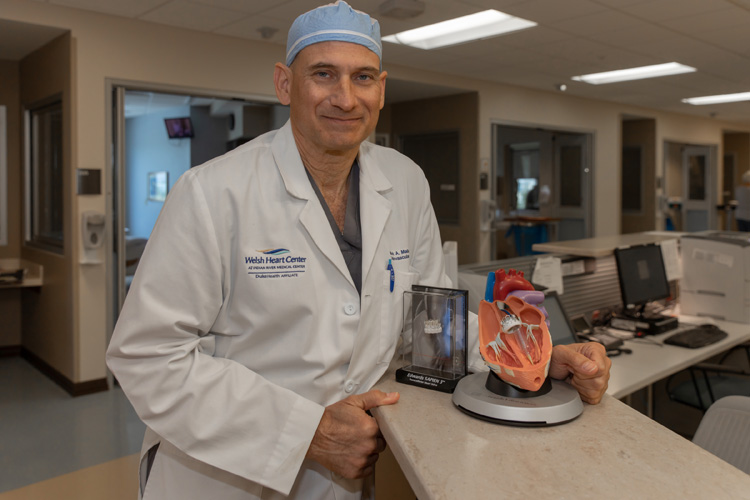
About the same time the Welsh Heart Center at Cleveland Clinic Indian River Hospital completed its 100th trans-catheter aortic valve replacement (TAVR) procedure here, the New England Journal of Medicine and the American College of Cardiology released the results of two new clinical trials on the use of TAVR for a whole new class of patients.
TAVR is a procedure that allows the replacement of heart valves without cutting the chest open by means of a catheter threaded up through a vein or artery in the groin to the heart.
The procedure was first approved by the FDA in 2012 but it was restricted to patients with severe aortic stenosis – narrowing of the heart’s aortic valve – that were considered at “high risk” for traditional open-heart surgery, which is called a sternotomy.
In 2016 the FDA expanded its approval to include patients considered at “intermediate risk” for a sternotomy and this March’s clinical trial results appear to have thrown open the doors for much younger, healthier, lower-risk patients to be eligible for TAVR procedures.
On the day the trial results were released, the New York Times proclaimed “tens of thousands of heart patients may not need open-heart surgery.”
It went on to say “TAVR has been reserved mostly for patients so old and sick they might not survive open-heart surgery. Now, two large clinical trials show that TAVR is just as useful in younger, healthier patients,” adding that “it might even be better, offering lower risks of disabling strokes and death, compared to open-heart surgery.”
Despite that euphoria, cardiovascular surgeon Dr. Mark Malias at the Welsh Heart Center is urging at least a modicum of caution.
“There is very little question in my mind that TAVR is going to be opened to low-risk patients but just because it’s available doesn’t mean it’s the best option for those patients,” says Malias.
“The study doesn’t say that TAVR is better [than traditional surgery],” Malias explains. “The study says TAVR is better at one year. For a 50-year-old patient, one year’s worth of data isn’t enough for me to say TAVR is better than surgical aortic valve replacement.”
“I have no problem,” he continues, “recommending TAVR over surgical aortic valve [replacements] for people in their 80s or 90s, because we have already accumulated eight years of data that looks pretty darn good.”
But Malias says “we are going to have to wait before we know the durability data” on the latest generation of biological tissue valves used in TAVR before he feels confident in recommending their use in younger, lower-risk patients.
Rhetorically, Malias asks, “Would I tell that 50-year-old guy that when he’s 55, he’s going to have to have it re-done and get it re-done again when he’s 60 and then at 65 and 70 and 75? Pretty quickly you will start to realize that it’s not a superior therapy for that low-risk patient when I can put a mechanical valve in a 50-year-old and say, ‘this valve is going to last you your lifetime.’”
While there are a wide variety of replacement valves available, they generally are divided between “mechanical” and “tissue.”
In trans-catheter aortic valve replacements, a replacement valve must be small enough and flexible enough to fit into a very narrow catheter, be propelled through that catheter through the veins/arteries from the groin all the way up and over to the heart, inflated and then placed inside the damaged aortic valve.
That’s not possible with mechanical valves which are made with strong, durable metals, plastics and pyrolytic carbon.
While Malias and Welsh Heart Center medical director Dr. Cary Stowe are among the first cardiovascular surgeons in Florida to perform these TAVR procedures, Malias clearly wants more evidence on how long these tissue valves will last.
“It’s a great technology,” Malias says, “however, we still have to be judicious on who we recommend have it and who would benefit and who might not benefit from it.”
It’s all about matching the right procedure to the individual patient.
“When I see a patient for aortic stenosis, we talk about options for valve replacements. We have the traditional sternotomy where we open the breast bone in the front and I have access to all aspects of the heart. For some patients that’s the ideal treatment option.
“If I’m going to offer someone a minimally invasive single valve replacement, I will offer them a right anterior thoracotomy where I do not divide the breast bone. I put them on the heart/lung machine through arteries in their leg. We can stop their heart once we open the chest through a little key-hole incision and replace the valve surgically without dividing their breast bone.
“If they are high risk for an open procedure, I would recommend TAVR. Even if they are at intermediate risk in the right age population, I would offer them a TAVR.” But until more data is accumulated, this particular cardiovascular surgeon isn’t ready to recommend the procedure to all younger, healthier patients just yet.
Dr. Mark Malias is a cardiovascular surgeon with the Welsh Heart Center at the Cleveland Clinic Indian River Hospital. His office is at 3450 11th Court, Suite 105 in Vero Beach. The phone number is 772-563-4580.



